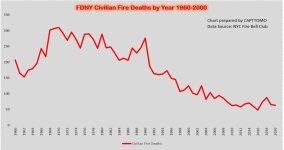You are using an out of date browser. It may not display this or other websites correctly.
You should upgrade or use an alternative browser.
You should upgrade or use an alternative browser.
Stats and Trends - Chart FDNY Civilian Fire Deaths by year 1960 thru 2020
- Thread starter Capttomo
- Start date
If you look at the numbers on this chart, civilian fire deaths jumped significantly in the late 1960s (start of War Years) and stayed high through the 1970s and 1980s. Then, civilian fire deaths dropped as the 1990s began and returned to pre-1968 levels. Fewer fires would be a factor but it does not appear that there was a corresponding significant drop-off in fires as the 1990s began.
What changed in 1990 to cause the significant civilian death drop, which has since continued to gradually decline?
What changed in 1990 to cause the significant civilian death drop, which has since continued to gradually decline?
- Joined
- Sep 7, 2020
- Messages
- 2,378
Absolutely, all of those has to have had a major impact on the reduction of civilian fire deathsLikely drop in fatalities is due to smoke detectors, installation of sprinkler systems when buildings are being renovated and/or newly constructed and increased awareness of fire safety practices (with the exception of lithium-ion battery related fires).
I had heard the story of a fire death only within 24 hours of a fire, but then was told the BFI either follows up or is notified if a fire death occurs later on (I don't know what, or if a, time limit exists).
A member who succumbs after 24 hours is considered a line-of-duty death, so why shouldn't a civilian's death be considered fire-related?
That 24-hour period, I believe, applies to when the DC's fatal fire investigation report is required.
Maybe a fire marshal can shed some light on this.
A member who succumbs after 24 hours is considered a line-of-duty death, so why shouldn't a civilian's death be considered fire-related?
That 24-hour period, I believe, applies to when the DC's fatal fire investigation report is required.
Maybe a fire marshal can shed some light on this.
As Mark Twain said. There are liars, there are damn liars and then there are statisticians!I had heard the story of a fire death only within 24 hours of a fire, but then was told the BFI either follows up or is notified if a fire death occurs later on (I don't know what, or if a, time limit exists).
A member who succumbs after 24 hours is considered a line-of-duty death, so why shouldn't a civilian's death be considered fire-related?
That 24-hour period, I believe, applies to when the DC's fatal fire investigation report is required.
Maybe a fire marshal can shed some light on this.
You can make numbered look any way you need
- Joined
- Jul 20, 2022
- Messages
- 437
You are Correct. In the FDNY if someone lived for 24 hours or more, their death was not counted as a fire death. It is crazy but true.If I remember correctly back in the 70’s the FDNY changed the definition of Fire Deaths. I believe they only classified it a fire related death if it occurred within 24hrs of fire.
Maybe a historian or someone with a better memory can correct me.
Captain Bob Rainey FDNY Engine 26 Retired.
The FDNY does not complete a civilian death report if a victim lives for more than 24 hours. However, the medical examiner, after an autopsy, will contact the Fire Marshall's any time fire is listed on a death certificate. The Fire Marshall keeps the official # of fire deaths reported by the Medical Examiner. This number (not the number of victims that died within 24 hours) is the official # of deaths reported each year.Starting in the 60's NY would tout the fact that they had much fewer fire deaths than other large cities. Of course they never mentioned the 24 hour rule when the other cities didn't have the same time limit.
If a victim lives into a new year and then passes...the Fire Marshall will go back and adjust the year in which the victim was removed.


